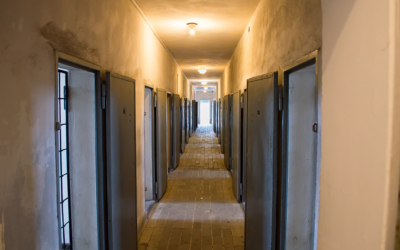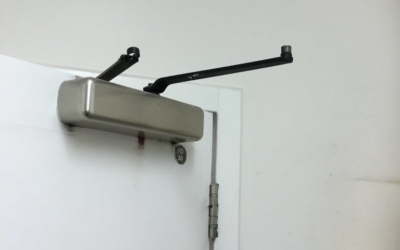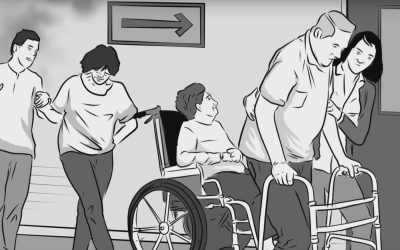There are many challenges to managing fire safety in a care home. Elderly people are often less mobile; they may use walking sticks or wheelchairs or be unable to walk without assistance. It can be a struggle for many to move around easily. Emergency evacuation is not a straightforward procedure.
Vulnerable people may have a slower reaction time to fire alarms. Conditions such as dementia will cause confusion and forgetfulness, leading to ovens not being turned off, or cigarettes not being properly extinguished.
A 2014/15 government report found that 41% of all fatalities from fires in England were people aged 65 and over. This makes the elderly 10 times more likely to die in a fire than younger people.
All of this means that care homes are at high risk of fire and their fire safety procedures need to be more complex than in other residences.
Top tips
Fire risk assessments
By law, all care homes must have a fire risk assessment. This needs to be regularly checked and updated. The fire risk assessment must show that reasonable precautions to protect residents and employees have been taken.
Frequent checks of the building need to be made. Things to look out for include:
- Fire doors are closing properly and are not wedged or propped open
- Fire extinguishers are present and in working order
- Fire hazards such as faulty electrical equipment or overloaded power sockets are dealt with
- Evacuation routes are clear of obstacles
- General housekeeping — anything can turn lethal if it comes into contact with the heat of a fire, so keep areas tidy to reduce this risk and keep people safe.
Click here for more information on fire risk assessments.
Fire safety training
Training should be spread out throughout the year and all staff should be trained in how to use fire extinguishers. All employees need fire safety training on their first day.
It’s important that all staff know what to do when the fire alarm sounds. What is the evacuation plan? Who are the fire wardens?
How many fire wardens do we need?
A care home is considered a high-risk premises so the number of fire wardens recommended is as follows:
Fewer than 15 employees/residents — At least one fire warden
15-50 employees/residents — At least two fire wardens
For every additional 50 — One additional fire warden
It’s important to remember that all shifts must be adequately covered, so you may have to nominate additional fire wardens to ensure there are enough fire wardens for each shift.
Fire drills
The law says that fire drills need to be done, as a minimum, once a year. However all employees must do a drill at least once a year, so you may need to do more than one if people are not in on drill day or if new employees are hired.
Fire drills need to be recorded in the fire risk assessment. If any particular risks or hazards are identified, they need to be noted down and actioned.
Evacuation
In care homes there should be a personal emergency evacuation plan (PEEP) in place for each individual resident, detailing their needs and requirements. All staff should have access to, and be made aware of, these PEEPs.
It can be useful to set the fire alarm off and record each resident’s response and reaction to it. In some cases, a loud continuous noise can provoke unexpected reactions including violent outbursts or even seizures.
Horizontal evacuation might be required in a care home, which means moving residents to safe parts of the building, away from the fire. This method is used if residents are bedbound, for example, and it is difficult to do a full evacuation.
This method is dependent on passive fire resistance, i.e. walls, floors and doors need to be fire resistant so the fire does not spread.
For further information on passive fire resistance and the spread of fire, click here.
If residents are smokers, a separate smoking risk assessment is important.
Fire alarms
Resident welfare needs to be taken into consideration when testing alarms. Ensure that the test is done at the same time every week and that residents are warned.
It is a requirement for care homes to have an L1 fire alarm system. These are automatic fire detection systems designed to cover the whole building, including unused areas such as roof spaces. L1 systems are designed to have the earliest possible warning of fire for everyone in the building. This is particularly important in care homes as residents will need more time to evacuate safely.
It’s very important to stick to a fire alarm maintenance schedule to ensure the alarm system is in good working order.
Fire doors
Fire doors prevent the spread of smoke and fire. In the event of an emergency, employees will have the hard task of going around and informing the residents. Faith in the doors can help instil a sense of calm.
A fire door is heavy, and needs to be closed to serve its purpose. If you are an elderly resident in a care home, closed fire doors can be isolating. They are difficult to open and can cause injury if they close too quickly. This might mean residents stay in their room as they are concerned about moving through a heavy door safely.
It might be tempting to prop or wedge a fire door open but this is dangerous. If a fire door is wedged open, it won’t close in an emergency and fire and smoke will spread rapidly. This is particularly dangerous in care settings as residents will need more time to evacuate or will be unable to evacuate without assistance.
Deaf residents
Deaf or hard of hearing residents will be unable to hear a fire alarm. A system with flashing lights might be appropriate. Fireco’s Deafgard is placed under the pillow and vibrates and lights up when an alarm sounds. If a pager system is preferred, DMS alerts people by text message in an emergency.
Common sense is always useful when it comes to fire safety. If you see something that looks like a fire hazard, remove it, or speak to the person that can. Keep your risk assessment updated and ongoing and make sure everyone knows exactly what to do in an emergency. Knowledge and safety go hand in hand.
Further information
You might also like
How do fire doors affect the lives of care home residents?
Older people are often more vulnerable when it comes to accidents and emergencies which places huge importance on fire safety in care homes. Fire doors are essential for fire safety, but in the daily lives of care home residents, they can be problematic.
Why sheltered housing residents are damaging fire door closers
Sheltered housing residents sometimes damage or disable fire door closers to make them easier to open. This is unsafe and against fire regulations. What is the solution?
Silent evacuation of a care home
Evacuating a care home has its own unique challenges. Elderly residents could be bedbound, suffering from dementia, hard of hearing, or unable to move without assistance. Added to this is the distress that a loud fire alarm can cause to vulnerable residents.





